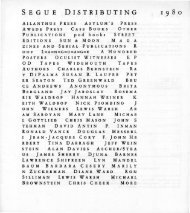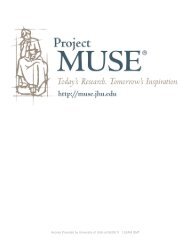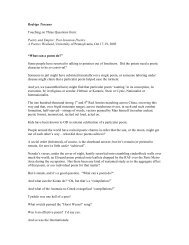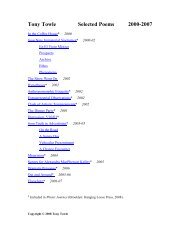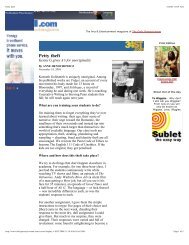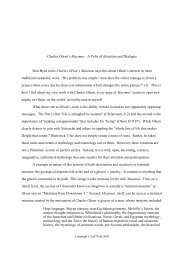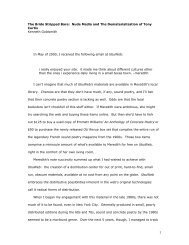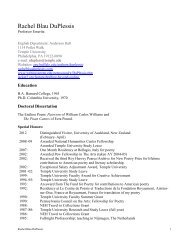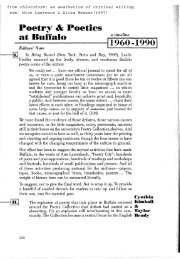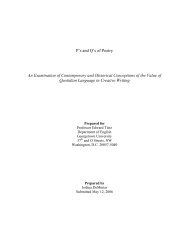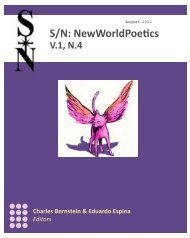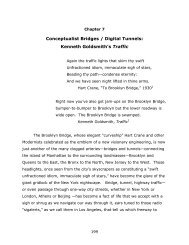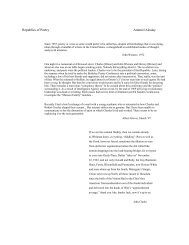'EASTER, 1916': YEATS'S FIRST WORLD WAR POEM
'EASTER, 1916': YEATS'S FIRST WORLD WAR POEM
'EASTER, 1916': YEATS'S FIRST WORLD WAR POEM
You also want an ePaper? Increase the reach of your titles
YUMPU automatically turns print PDFs into web optimized ePapers that Google loves.
FN:4<br />
FN:5<br />
FN:6<br />
228 marjorie perloff<br />
FN:3<br />
Tim Kendall chap12.tex V1 - October 4, 2006 1:50 P.M. Page 228<br />
We have no gift to set a statesman right;<br />
He’s had enough of meddling who can please<br />
A young girl in the indolence of her youth,<br />
Or an old man upon a winter’s night. 3<br />
The request had come from Henry James, who was helping Edith Wharton bring<br />
out a collection of war poems to raise money for the Belgian refugees in Paris. 4 The<br />
poem, first called ‘To a friend who has asked me to sign his manifesto to the neutral<br />
nations’ and then ‘A Reason for Keeping Silent’, inspired an angry response from<br />
the strongly anti-German Quinn, who told Yeats, ‘those five or six lines were quite<br />
unworthy of you and the occasion . . . . I do not believe in divorce between letters<br />
and life or art and war.’ 5<br />
The divorce persisted, however, during the winters with Ezra Pound at Stone<br />
Cottage, where in 1914–15 Yeats studied and adapted the stylized rituals of the Noh<br />
drama and completed the first volume of his autobiography, Reveries over Childhood<br />
and Youth. Pound, as James Longenbach notes, was becoming increasingly caught<br />
up in the war fever, especially after the death at the Front of his great artist friend<br />
Henri Gaudier-Brzeska in June 1915. But Yeats remained aloof: his own Noh play,<br />
At the Hawk’s Well, designed by Edmund Dulac and danced by Michio Ito, a disciple<br />
of Nijinsky from the Ballet Russe, had its first performance (4 April 1916) at Lady<br />
Cunard’s at what turned out to be, ironically enough, a war charity affair. 6 Having<br />
launched At the Hawk’s Well, Yeats set off for Sir William Rothenstein’s idyllic<br />
cottage in the Cotswolds to spend the Easter holiday. Sir William had planned to<br />
paint Yeats’s portrait.<br />
It was here on Easter Monday (24 April) that Yeats received word of the Rising.<br />
The rebellion moved him as no account of the Battle of the Somme or Verdun ever<br />
could, for the principals were mostly people he knew personally, and his own future<br />
hung in the balance. The Rising was the first decisive event to threaten Yeats’s ability<br />
to advance the Irish cause from his base in London, where he had lived a large<br />
part of his life, ever since his schooldays. It was in London, after all, that Yeats’s<br />
early writings were published, in London that he founded the Irish Literary Society<br />
(1891), the Gaelic League (1893), and so on. Even if he complained of being a<br />
stranger in London, Yeats held the privileged position of the Protestant Anglo-Irish<br />
Ascendancy. ‘The loose federation of personalities Yeats gathered around himself’,<br />
Declan Kiberd notes, ‘was one of the very first groups of decolonizing intellectuals<br />
to formulate a vision of their native country during a youthful sojourn in an<br />
3 Yeats, ‘On Being Asked for a War Poem’, in The Poems, ed. Daniel Albright (London: Dent,<br />
1990), 205.<br />
4 See James Longenbach, Stone Cottage: Pound, Yeats and Modernism (Oxford: Oxford University<br />
Press, 1988), 118.<br />
5 John Quinn, quoted in Albright, ‘Notes to Poems’, in Yeats, Poems, 579.<br />
6 See Foster, W. B. Yeats, ii. 40.



